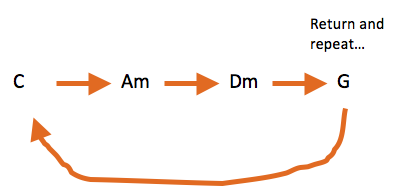A turn-around builds musical energy by its seamless back-to-the-beginning characteristic.
________________
 Get the entire “Essential Secrets of Songwriting” 10-eBook Bundle, with an 11th free eBook, “Creative Chord Progressions”. High-quality PDFs for laptop, desktop, iPad, or any other PDF-reading device.
Get the entire “Essential Secrets of Songwriting” 10-eBook Bundle, with an 11th free eBook, “Creative Chord Progressions”. High-quality PDFs for laptop, desktop, iPad, or any other PDF-reading device.
________________
 A turn-around is a progression, usually relatively short (4 or 5 chords), that ends in such a way that it seamlessly connects back to its beginning. In music theory terminology, that connection is called a melded cadence, which simply means that whatever chord would be the logical end of the progression is the same chord that starts it:
A turn-around is a progression, usually relatively short (4 or 5 chords), that ends in such a way that it seamlessly connects back to its beginning. In music theory terminology, that connection is called a melded cadence, which simply means that whatever chord would be the logical end of the progression is the same chord that starts it:
It’s because of this kind of “end-is-the-beginning” characteristic that the turn-around has a pleasant quality with a good deal of musical momentum.
To create your own turn-around that has this kind of forward energy, you might want to start with something easy, and then go for something more adventurous. Easy, in this context, means two things:
- Make your progression harmonically STRONG. This means that you want to create a progression that makes the first chord sound like the tonic chord. So circle-of-fifths progressions and other basic types are the way to go.
- Make your progression short. Longer progressions can be harmonically interesting, but might compromise the kind of energy that comes from a typical turn-around. We’ll get to longer progressions momentarily, but 4 or 5 chords should be plenty for now.
Some examples of good, short turn-arounds you may want to experiment with:
- C F Am G (I IV vi V)
- C Dm F G (I ii IV V)
- C G Am F (I V vi IV)
- C Dm C/E Dm (I ii I6 ii)
But what if you want something more adventurous? No matter how long a turn-around is, the only characteristic you want to be sure to retain is that the end becomes the beginning.
To create your own longer turn-around, try this:
- Start simple. Start your progression to be solidly in your song’s key. So even complex turn-arounds work well if the start of it is innocently targeting the tonic chord: C F Dm… for example.
- End simple. Complex turn-arounds work well if the final chord or two will connect seamlessly to the start. So if your progression is in C major, try to make the final chord something that moves easily to that chord, such as G, F or Dm.
- Insert the complex part in the middle. Let the middle of your progression be the area of harmonic complexity:

That harmonically interesting middle part works best if it connects well to the predictable bit that precedes and follows it.
So here are three ideas to get you started. (For chords with a slash: the note after the slash is the bass note):
- C F Dm G Ab Bb F G (Roman numerals: I IV ii V bVI bVII IV V) The first part, C-F-Dm, is the predictable part. The Ab-Bb are altered chords that don’t normally exist in C major, and then the F-G brings everything back to C major.
- C G Am Bb F D/F# Gsus G (Roman numerals: I V vi bVII IV V6/V Vsus4 V. This progression leans toward F major by adding in the chords Bb and F. Then the D/F# points to G, which then connects back to C.
- C Dm/C C Bbadd9/C Dm Em Eb F Eb Bb F (Roman numerals: I ii/4-2 I bVII/I ii iii bIII IV bIII bVII IV) This intersting turn-around comes from “Supper’s Ready“, from the 1972 album “Foxtrot” by Genesis. If you want to hear how they use it, start listening at about the 20’45” mark.
______________
 Written by Gary Ewer. Follow on Twitter.
Written by Gary Ewer. Follow on Twitter.
“The Essential Secrets of Songwriting” eBook Bundle shows you why and how good songs work. A complete and comprehensive set of manuals that will take your songs to a new level of excellence. (Buying today means you’ll receive a FREE copy of “Creative Chord Progressions“)











Pingback: Chord progressions | Pghboemike's Blog
It is truly amazing how many creative souls we have on this planet. Cultivating talent to new frontiers. I’m proud to be a part of this elite, unique group. ~Mark
Reblogged this on Jerry Rockwell's Dulcimer Blog and commented:
This is a very well-written, concise and timely article!